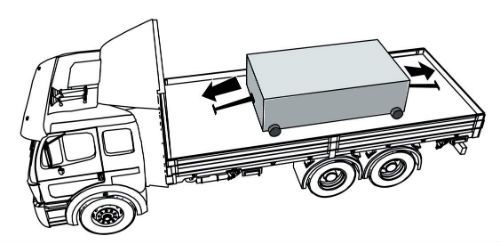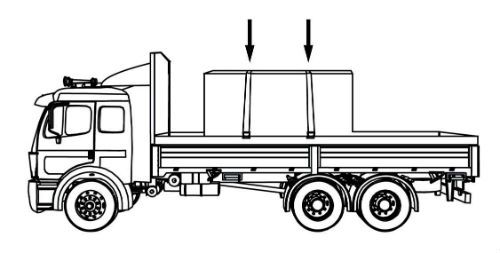CDL Practice Tests: Flatbed Cargo Securement
Choose A Section:
Go!When securing metal coils in a sided vehicle without anchor points:
- All of these apply
- Use friction mats
- Use locking and bracing
- Follow general cargo securement requirements
Securing Coils Transported in a Sided Vehicle or Intermodal Container without Anchor Points
To prevent metal coils from moving horizontally and/or tipping:
Follow general cargo securement requirements
Secure the coils using:
- Blocking and bracing
- Friction mats
- A combination of these.
When securing paper rolls on a flatbed or curtainside vehicle, it is acceptable to stack rolls with eyes vertical:
- Stacking rolls with eyes vertical is not acceptable
- When total weight is less than 5,000 lbs.
- When using tiedowns that wrap twice around the load.
- When temperature is 63 degrees F or more.
Special Circumstances: Loading and Securing Paper Rolls on a Flatbed Vehicle or a Curtain-Sided Vehicle
Requirements for eyes vertical or with eyes horizontal and lengthwise
Load and secure the paper rolls as described for a sided vehicle.
Attach tiedowns to secure entire load according to the general cargo securement requirements in Section 2.
Note: Stacked loads of paper rolls with eyes vertical are prohibited
A stack of shortwood loaded lengthwise can be secured with one tiedown if:
- All logs in the stack are less than 10 ft long.
- They are blocked in the back by the vehicle's end structure or another stack of logs.
- They are blocked in the front by a headboard or another stack of logs.
- All of these apply.
One tiedown
A stack can be secured with one tiedown if all logs in the stack less than 3.04 m (10 ft) are:
- Blocked in the front by a headboard strong enough to restrain the load or by another stack of logs.
- Blocked in the rear by the vehicle's end structure or another stack of logs.
The definition for "shortwood" identifies pieces that are no longer than:
- The width of the road.
- 16 ft
- Half the length of the trailer.
- 75 in
Shortwood
- Normally up to about 2.5 m (100 in) in length.
- No longer than 4.9 m (16 ft) in length.
-
Also called:
- Cut-up logs
- Cut-to-length logs
- Bolts
- Pulpwood
A bulkhead is defined as:
- A vertical barrier placed directly behind the cab of a tractor to protect the cab in the event cargo should shift forward.
- A vertical barrier across a vehicle to prevent forward movement of cargo.
- A structure, device, or another substantial article placed against or around an article to prevent horizontal movement of the article.
- A vertical barrier across the front of the deck of a vehicle to prevent forward movement of cargo.
Bulkhead:
A vertical barrier across a vehicle to prevent forward movement of cargo.
What is the maximum weight that can be secured by a tiedown with a marked WLL of 5,000 lbs?
- 6,000 lbs
- 5,000 lbs
- 10,000 lbs
- 2,500 lbs
Note: The minimum WLL requirement for the securement system is 50%. More tiedown capacity should be used if you need to secure an article against any movement.
When banding paper rolls with eyes vertical, you should:
- Apply bands loosely.
- Spread rolls apart from each other.
- Secure bands with tape, hangers, or other means.
- All of these are necessary.
Banding
If paper rolls are banded together:

- Place rolls tightly against each other to form a stable group.
- Apply bands tightly.
- Secure bands with tape, hangers, or other means so that the bands cannot fall off the rolls or slide down to the deck.
When using tiedowns for securing cargo, what is the general rule regarding cargo length.
- 2 tiedowns for every 10 ft, or part thereof.
- 1 tiedown for every 5 ft, or part thereof.
- 1 tiedown for every 15 ft, or part thereof.
- 1 tiedown for every 10 ft, or part thereof.
When cargo is prevented from forward movement (for example, by the headboard, bulkhead, other cargo, or tiedown), secure the cargo according to the following requirements:

All Cargo:
1 tiedown for every 10 ft, or part thereof.
What is the minimum requirement for securing roll-off and hook containers?
- One tiedown attached to both the vehicle chassis and the container chassis.
- Two tiedowns installed lengthwise, each securing one side of the container to one of the vehicle's side rails.
- All of these are acceptable.
- Two hooks, or an equivalent mechanism, securing both sides of the container to the vehicle chassis.
Secure to the rear of the vehicle with at least one of the following three mechanisms:
-
Rear Mechanism 1:
One tiedown attached to both the vehicle chassis and the container chassis.
-
Rear Mechanism 2:
Two tiedowns installed lengthwise, each securing one side of the container to one of the vehicle's side rails.
-
Rear Mechanism 3:
Two hooks, or an equivalent mechanism, securing both sides of the container to the vehicle chassis at least as effectively as the tiedowns in the two previous items.
What is the minimum Working Load Limit for the entire securement system?
- 50% of cargo weight.
- 20% of cargo weight.
- 80% of cargo weight.
- 100% of cargo weight.
Note: The minimum WLL requirement for the securement system is 50%. More tiedown capacity should be used if you need to secure an article against any movement.
About The Flatbed Cargo Securement CDL Manual
Studying the flatbed cargo securement CDL manual is not a requirement for getting your CDL permit or license. It is required knowledge for flatbed drivers.
Some questions you should be able to answer for flatbed cargo securement:
- What is the minimum Working Load Limit of a tiedown used to secure logs?
- What is the minimum weight of a shipment of paper rolls that would require specific securement requirements?
- When securing concrete pipe over 45 inches loaded crosswise, which direction must the tiedowns on the front half of the load run?
- What is a cab shield?
- When securing concrete pipe over 45 inches loaded crosswise, which direction must the tiedowns on the rear half of the load run?
- What is a dunnage bag?
- Who is responsible for inspecting securing devices and cargo within the first 50 miles?
- How many tiedowns are required on a stack of shortwood loaded crosswise?
- What is the minimum working load limit of each tiedown used to secure crushed or flattened vehicles?
- Define 'bolster'
- What is a hook-lift container?
- When a tiedown is attached directly to the cargo, what is the ideal angle where it attached to the vehicle?
What is a securing device?
Any device specifically manufactured to attach or secure cargo to a vehicle or trailer:
- Synthetic Webbing
- Chain
- Wire rope
- Manila rope
- Synthetic rope
- Steel strapping
- Clamps and latches
- Blocking
- Front-end structure
- Grab hooks
- Binders
- Shackles
- Winches
- Stake pockets
- D-rings
- Webbing ratchet
- Bracing
- Friction mat
What is a tiedown?
A combination of securing devices that forms an assembly that:
- Attaches cargo to, or restrains cargo on a vehicle.
- Is attached to anchor point(s).

Some tiedowns are attached to the cargo and provide direct resistance to restrain the cargo from movement.

Some tie-downs pass over or through the cargo. They create a downward force that increases the effect of friction between the cargo and the deck. This friction restrains the cargo.
 Related Cargo Securement Terms That Every Driver Should Know:
Related Cargo Securement Terms That Every Driver Should Know:
-
Tiedown:
A combination of securing devices which form an assembly that attaches cargo to, or restrains cargo on, a vehicle or trailer, and is attached to anchor point(s).
-
Contained:
Cargo is contained if it fills a sided vehicle, and every article is in contact with or sufficiently close to a wall or other articles so that it cannot shift or tip if those other articles are also unable to shift or tip.
-
Blocking:
A structure, device, or another substantial article placed against or around an article to prevent horizontal movement of the article.
How should tiedowns be attached?
Tiedowns can be used in two ways:
-
Attached to the cargo:
- Tiedowns attached to the vehicle and attached to the cargo.
- Tiedowns attached to the vehicle, pass through or aroundan article of cargo, and then are attached to the vehicle again.
-
Pass over the cargo:
- Tiedowns attached to the vehicle, passed over the cargo, and then attached to the vehicle again.
Tiedown placement:

Place the tiedown as close as possible to the spacer.
Position the tiedowns as symetrically as possible over the length of the article.

Position the tiedowns to preserve the integrity of the article.







 TT On Facebook
TT On Facebook